Wireless communication test technology and test equipment are important supporting forces of the communication industry. It penetrates into almost all industrial chain links such as communication chips, modules, terminals, base stations, and wireless networks. It runs through design and development, certification and acceptance, production, and network construction. Optimize almost complete industry life cycle.
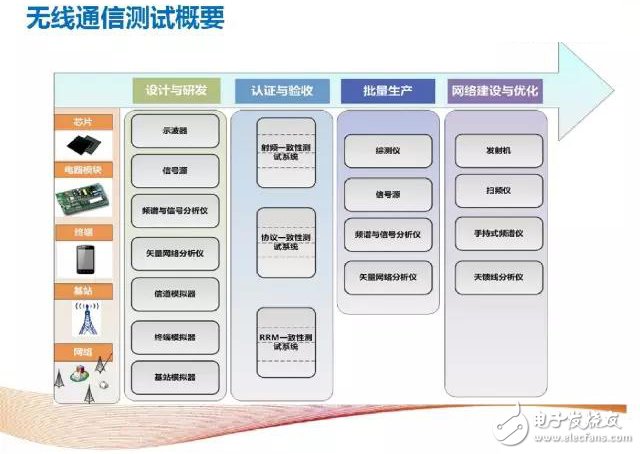
Design and development are the most widely used stages of test instruments, including general purpose measuring instruments such as oscilloscopes, signal sources, spectrum analyzers (signal analyzers), vector network analyzers, and channel simulators, terminal simulators, and base station simulators. Special high-end test instruments; in the certification and acceptance phase, the main test equipment includes RF conformance test system, protocol conformance test system, RRM conformance test system; common instruments in the production stage of communication enterprises are familiar terminal testers, As well as the common test instruments such as the signal source and spectrum analyzer mentioned above; in the network construction and optimization stage, various engineering instruments such as transmitters, sweepers, and handheld spectrum analyzers are commonly used measurement tools.
Second, the status of 4G wireless communication testNext, we will talk about the status of 4G wireless communication test from the perspectives of system equipment testing, chip and terminal testing, RF testing and network planning network optimization testing.
1, 4G system equipment test - vector signal source and signal analyzer
Vector signal source and vector signal analyzer are high-end general-purpose electronic measuring instruments for R&D, production and conformance testing of communication equipment such as base stations. Their technical characteristics are mainly reflected in the following aspects.
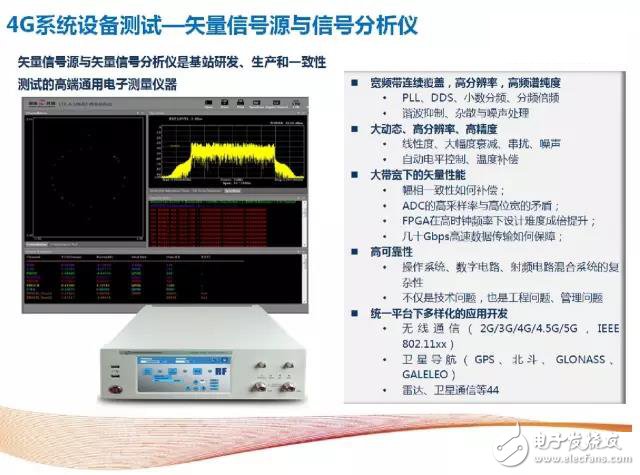
First, in terms of frequency, PLL, DDS, fractional frequency division, and frequency division multiplication are used to support wide-band continuous coverage from several kHz to several GHz, and the frequency resolution can reach 0.01 Hz. In addition, the spectrum purity is high, harmonic suppression, Spurious and noise processing can achieve higher index requirements;
Second, in terms of amplitude, vector signal sources and analyzers typically have a large dynamic range of 150 dB or more, a high resolution of 0.01 dB, and a ±1 dB accuracy index, good linearity, large attenuation, crosstalk, and noise suppression. Excellent performance with automatic level control and temperature compensation;
Third, in terms of vector performance, with the dramatic increase in bandwidth requirements in the 3G to 5G era, large bandwidths are compensated for amplitude and phase uniformity, the high sampling rate of ADCs and high bit widths are contradictory, and FPGAs are difficult to design at high clock frequencies. A series of technical difficulties such as double improvement and how to guarantee high-speed data transmission of tens of Gbps;
Fourth, in engineering development, in order to ensure high reliability of testing, the hybrid system composed of operating system, digital circuit and RF circuit is more complicated;
Fifth, in application development, vector signal sources and analyzers are often based on a unified platform to support multiple applications in multiple communication formats, such as wireless communication (2G/3G/4G/4.5G/5G, IEEE 802.11xx), satellite Navigation, radio, etc. New applications are also driving the technological evolution of instrumentation.
Sixth, the number of channels, with the application of MIMO technology, multi-channel MIMO signal source and analyzer is also one of the direction of technological evolution, of course, it also challenges the reliability of the instrument system and electromagnetic compatibility design.
2, 4G system equipment test - wireless channel simulator
In addition to the familiar general-purpose instruments such as signal sources and signal analyzers, there is an important high-end test instrument in communication test: wireless channel simulator.
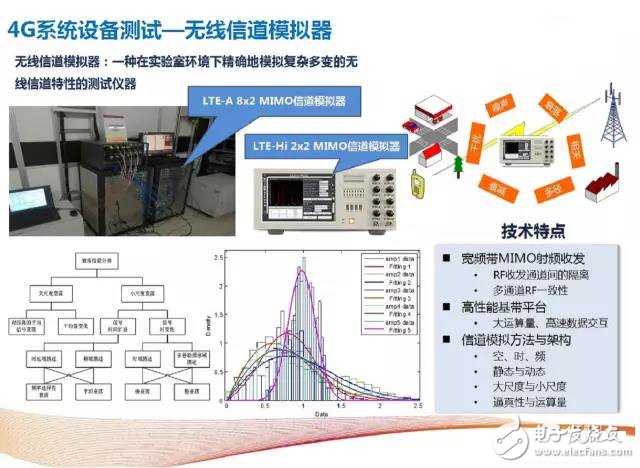
Channel is one of the foundations of wireless communication physical layer technology research. MIMO channel has been a research hotspot in academic circles in recent years. The MIMO channel simulator is an instrument that accurately and reproducibly simulates complex wireless channel environments under laboratory conditions. It has similar technical features to signal sources and signal analyzers, such as wideband and large bandwidth.
In addition, due to the bidirectional link characteristics of the channel simulator, the channel isolation index and multi-channel RF consistency of the broadband RF front end are highly demanded; due to the complexity of the MIMO channel, the mathematical model is implemented for baseband operations. The resource, data exchange rate, etc. are very demanding, so the design of the baseband and algorithm architecture is extremely important.
In addition, with the deepening of 3D MIMO/Massive MIMO and high-frequency channel characteristics research, the channel simulation method and architecture are gradually evolving.
3, 4G chip and terminal test - comprehensive tester
During the 4G period, with the development of the chip manufacturing process, the mainstream process of the chip has entered a new technology stage from 28 nm, and the processor core of the chip has also developed to a 64-bit application processor chip or an 8-core processing solution.
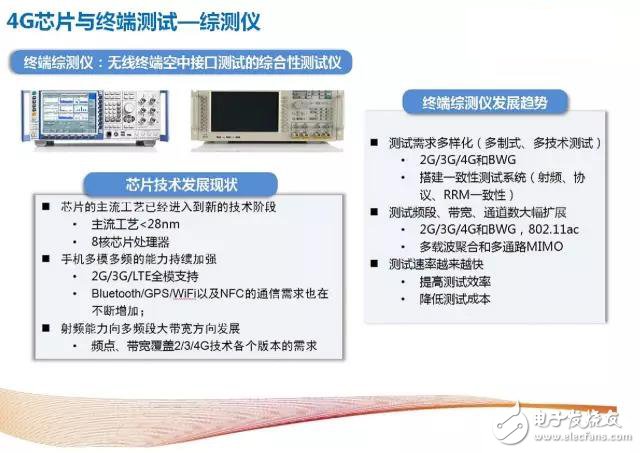
In the 4G era, the capability of multi-mode multi-frequency continues to strengthen, and the demand for full-mode support capability of 2G/3G and LTE (TDD/FDD) continues to grow. At the same time, the communication requirements of Bluetooth/GPS/WIFI and NFC of mobile phones are also In terms of radio frequency, the frequency and bandwidth capabilities of mobile phones cover the requirements of 2/3/4G technologies. For example, the R10 version requires the terminal to support 5CC maximum 100M downlink bandwidth. In subsequent versions, the terminal needs to support MIMO and cross. Band carrier aggregation and carrier aggregation of different formats of TDD-FDD.
In order to adapt to the development of these chips and terminals, the traditional comprehensive measurement technology also needs to be reformed accordingly: In order to meet the diverse test requirements, a single terminal test instrument needs to have various communication systems (2G/3G/4G and BWG). The air interface protocol stack simulation capability is adapted to the network side simulation requirements of the terminal development process, and the terminal test instrument should have the capability of building an RF/protocol/RRM conformance test system through the integrated and open interfaces;
In addition, due to the large expansion of the test frequency band, bandwidth, and channel number, the comprehensive measurement instrument RF capability needs to support the test frequency from 400M to 6GHz, to meet the accuracy and stability of performance and stability in each working frequency band, and to achieve more through function expansion. Carrier aggregation and verification capabilities of multi-path MIMO;
In response to the requirements for efficiency and cost in the production process of the terminal, the line test technology of the mobile phone tester has been changed from the traditional signalling test to the faster non-signaling mode, and the full-band calibration and full-system of the mobile phone One-stop testing has become a common solution for mobile phone production line testing.
4, 4G RF test - vector network analyzer
Vector network analyzer is mainly used to measure the S-parameters of RF devices. It has the advantages of high performance, large dynamics and low noise. It is widely used in the research and development of RF devices and components in mobile communications, military radar, semiconductor, radio and television, scientific research and education. And production testing.
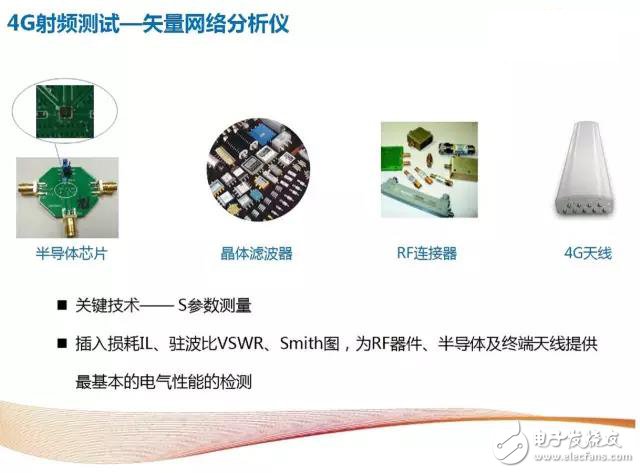
The RF devices in the 4G era are available in a variety of forms, including semiconductor chips, filters, RF connectors, and antennas. Vector network analyzers are no longer limited to S-parameter measurements. They also feature insertion loss IL, standing wave ratio VSWR, and Smith maps to provide the most basic performance test for RF devices, semiconductors, and terminal antennas.
In recent years, the main development directions of the vector network include: nonlinear measurement, multi-port parallel test, millimeter wave and even THz band penetration.
5, 4G network planning and optimization test
Instruments such as sweepers, transmitters, handheld spectrum analyzers, and handheld antenna feeder analyzers are widely used in outdoor analog testing and indoor coverage testing. Among them, the outdoor simulation test includes propagation model correction and base station coverage test; the indoor coverage test mainly includes the room system design verification and system acceptance.
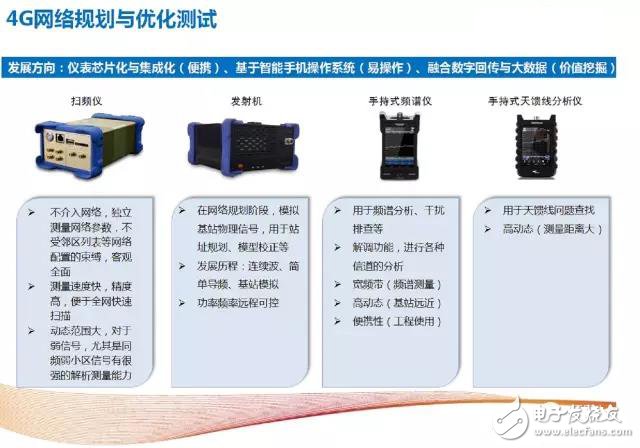
The sweeper has the outstanding features of fast scanning speed, high sensitivity, large dynamic range and independent testing on the network; the transmitter has experienced the development process from transmitting continuous wave to transmitting simple pilot to analog base station, and supports remote controllable; The handheld spectrum analyzer is used for spectrum analysis, interference check, etc. It can demodulate parameters for analysis of various channels, and has outstanding advantages such as wide frequency band, high dynamics, and portability. The handheld antenna feeder analyzer is used to find the antenna feeder. Problem, the measurement distance is large, convenient and flexible.
The network planning network optimization test belongs to the field of engineering testing. In addition to satisfying the basic testing functions, the requirements for the instrument are developing in the direction of portability, easy operation and big data sensing.
Third, 5G and IoT test technology developmentRegarding the development of 5G and IoT test technologies, I will talk about 5G signal sources and analyzers, 5G massive MIMO digital multibeam test, Massive MIMO array antenna test, NB-IoT test and 5G channel simulator.
1, 5G signal source and analyzer
Signal sources and analyzers will continue to be the most important universal measuring instruments in the 5G era. 5G signal source and analyzer, the working frequency range needs to cover the range from low frequency to microwave millimeter wave, while supporting vector signal bandwidth of 500MHz or even several GHz.
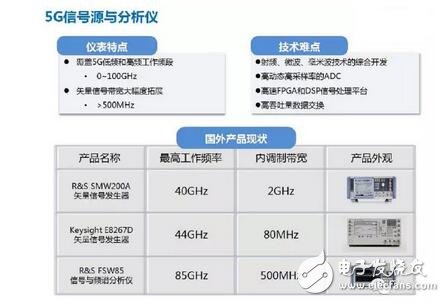
Signal generation and analysis of several GHz bandwidth, the main technical difficulties include the comprehensive development of RF, microwave, millimeter wave technology, high dynamic high sampling rate ADC, high speed FPGA and DSP signal processing platform, and high throughput data exchange. In terms of frequency coverage, the frequency of high-end vector signal sources in foreign countries has reached 44 GHz, and the operating frequency of vector signal analyzers can reach 85 GHz. In terms of modulation bandwidth, the modulation bandwidth of R&S's vector signal source SMW200A can reach up to 2 GHz.
At present, domestic instrument manufacturers have not made significant progress in this field, and hope to cooperate in the future to break through the technical bottleneck and make up for the market gap.
2, 5G massive MIMO digital multi-beam array test
The digital multi-beam array based on the digital domain-based beamforming principle of 5G massive MIMO can provide high-gain narrow beam with high spatial resolution, flexible spatial multiplexing capability and low inter-user interference.
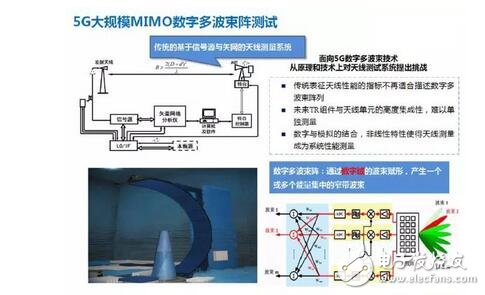
The traditional antenna measurement system is based on the signal source and the vector network, and the digital multi-beam scheme makes the traditional antenna measurement system unrecyclable from both the principle and the technical level: the traditional characterization of the antenna performance is no longer suitable for describing the digital multi-beam array; the future The Tx/Rx components are highly integrated with the antenna unit and cannot be measured separately; the nonlinearity caused by the mixing of digital and analog makes the antenna measurement a measure of system performance.
3, Massive MIMO array antenna test
As one of the key enabling technologies of 5G, large-scale antenna technology inevitably brings a series of challenges to antenna testing. Traditional multi-port testing is mostly based on single-satellite step-by-step testing or multiple vector cascading tests. The drawbacks of slow test speed and complex channel calibration are common. In addition, due to the introduction of matrix switches, performance such as dynamic range is deteriorated.
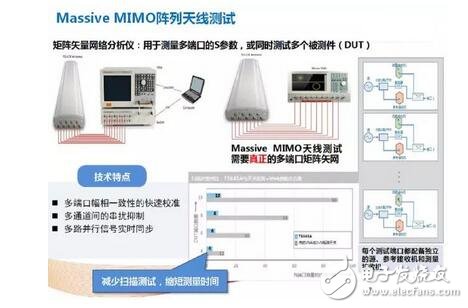
Massive MIMO antenna testing requires a true multiport matrix vector network. The multi-port vector network can simultaneously test multi-port S-parameters, which effectively reduces the measurement time. At the same time, each test port is equipped with independent source, reference receiver and measurement receiver, which can test multiple DUTs in parallel.
The main technical difficulties of multi-port vector network analyzer include fast calibration of large-scale multi-port amplitude and phase consistency, crosstalk suppression between multiple channels, and real-time synchronization of parallel multi-channel signals.
4, NB-IoT test
With the standard freeze in July 2016, NB-IoT has a broad application prospect as a new generation of Internet of Things.
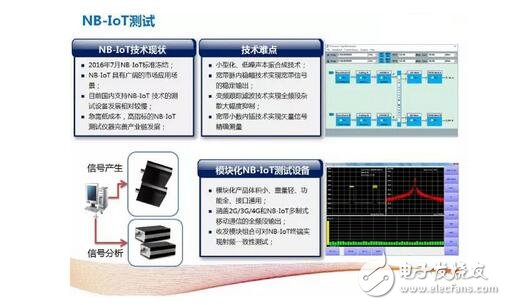
At present, there are relatively few test equipments supporting NB-IoT technology in China, and there is an urgent need for low-cost, high-index NB-IoT test instruments to improve the development of the industrial chain. Some potential key technologies will greatly accelerate the development of NB-IoT test instruments, such as miniaturized, low-noise local oscillator synthesis technology, wideband pulse stabilization technology can be used to achieve stable output of wideband signals, and variable frequency tracking filter technology is available. To achieve large-scale spurs large-scale suppression, broadband fractional interpolation technology can achieve accurate measurement of vector signals.
5, 5G channel simulator
The 5G channel simulator will achieve greater bandwidth above 500MHz, cover higher frequencies above 6GHz, and support a rich variety of 5G channel models on a multi-channel (64, 128 or even more) basis. At present, the existing channel simulators in the world cannot meet the 5G requirements on key indicators such as working frequency, channel number and bandwidth.
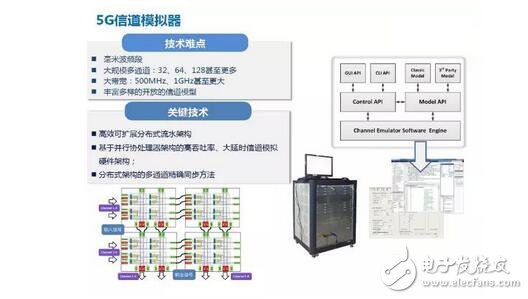
However, in recent years, many enterprises in China have developed 8x8 MIMO channel simulators for 4G testing, laying a technical foundation for the development of 5G channel simulators in terms of hardware architecture and algorithm architecture.
ac dc adapter,dc adapter,ac adapter 12v,dc power adapter,ac dc adapter 24v
FOSHAN SHUNDE KELICHENG POWER SUPPLY TECHNOLGY. CO,LTD , http://www.kelicpower.com
